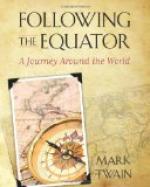The drive through the town and out to the Galle Face by the seashore, what a dream it was of tropical splendors of bloom and blossom, and Oriental conflagrations of costume! The walking groups of men, women, boys, girls, babies—each individual was a flame, each group a house afire for color. And such stunning colors, such intensely vivid colors, such rich and exquisite minglings and fusings of rainbows and lightnings! And all harmonious, all in perfect taste; never a discordant note; never a color on any person swearing at another color on him or failing to harmonize faultlessly with the colors of any group the wearer might join. The stuffs were silk-thin, soft, delicate, clinging; and, as a rule, each piece a solid color: a splendid green, a splendid blue, a splendid yellow, a splendid purple, a splendid ruby, deep, and rich with smouldering fires they swept continuously by in crowds and legions and multitudes, glowing, flashing, burning, radiant; and every five seconds came a burst of blinding red that made a body catch his breath, and filled his heart with joy. And then, the unimaginable grace of those costumes! Sometimes a woman’s whole dress was but a scarf wound about her person and her head, sometimes a man’s was but a turban and a careless rag or two—in both cases generous areas of polished dark skin showing—but always the arrangement compelled the homage of the eye and made the heart sing for gladness.
I can see it to this day, that radiant panorama, that wilderness of rich color, that incomparable dissolving-view of harmonious tints, and lithe half-covered forms, and beautiful brown faces, and gracious and graceful gestures and attitudes and movements, free, unstudied, barren of stiffness and restraint, and—
Just then, into this dream of fairyland and paradise a grating dissonance was injected.
Out of a missionary school came marching, two and two, sixteen prim and pious little Christian black girls, Europeanly clothed—dressed, to the last detail, as they would have been dressed on a summer Sunday in an English or American village. Those clothes—oh, they were unspeakably ugly! Ugly, barbarous, destitute of taste, destitute of grace, repulsive as a shroud. I looked at my womenfolk’s clothes—just full-grown duplicates of the outrages disguising those poor little abused creatures —and was ashamed to be seen in the street with them. Then I looked at my own clothes, and was ashamed to be seen in the street with myself.
However, we must put up with our clothes as they are—they have their reason for existing. They are on us to expose us—to advertise what we wear them to conceal. They are a sign; a sign of insincerity; a sign of suppressed vanity; a pretense that we despise gorgeous colors and the graces of harmony and form; and we put them on to propagate that lie and back it up. But we do not deceive our neighbor; and when we step into Ceylon we realize that we have not




